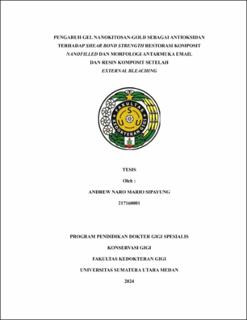Pengaruh Gel Nanokitosan-Gold sebagai Antioksidan terhadap Shear Bond Strength Restorasi Komposit Nanofilled dan Morfologi Antarmuka Email dan Resin Komposit Setelah External Bleaching
The Effect of Nanokitosan-Gold Gel as an Antioxidant on the Shear Bond Strength of Nanofilled Composite Restoration and the Morphology of Enamel-Composite Resin Interface After External Bleaching

Date
2024Author
Sipayung, Andrew Naro Mario
Advisor(s)
Abidin, Trimurni
Agusnar, Harry
Metadata
Show full item recordAbstract
Introduction: Patients often require additional aesthetic interventions such as, replacement of old restorations or application of laminate veneers to restore aesthetic deficiencies following bleaching procedures. Composite restoration attachment after in-office bleaching treatment cannot be done immediately, due to the presence of free radical residues which can reduce the shear bond strength of the composite resin so a delay of 1-3 weeks is recommended. The use of antioxidants can be highlighted since it seems to be a more effective alternative to reduce or remove the residual oxygen and immediate improvement in SBS. Sodium ascorbate is an antioxidant substance known to bind free radical residues, thereby shortening the delay in restoration. Natural resources are being developed as antioxidants which is nanochitosan gold which is rich in antioxidants.
Purpose: The purpose of this study was to compare the differences in the use of the antioxidant sodium ascorbate and nanochitosan gold can increase shear bond strength to the restoration of nanofilled composite resin and to see the morphology of the enamel and resin composite interface after external bleaching. Methods: Thirty insisivus teeth were divided into three groups. Every sample was bleached, and labial veneering direct preparation. Group I as control without antioxidant. Group II application nanochitosan gold and group III application sodium ascorbate 10%. All samples were restored with nanofilled composites and then subjected to shear bond strength tests and Scanning Electron Microscopy tests. Results: The highest mean shear bond strength of composite resin was in group which is bleached 40% hydrogen peroxide and used antioxidant nanochitosan gold, while the lowest was in group control bleached using 40% hydrogen peroxide and immediate restoration without antioxidant. Conclusion: Application nanochitosan gold was potencial antioxidant increase on shear bond strength of composite resin restoration in bleached by 40% H2O2.
Collections
- Master Theses [69]
